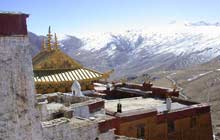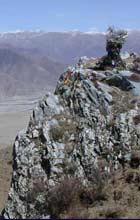
 Prophesied by the historic Buddha approximately about 2,000 years before his birth, Tsongkhapa (1357-1419) was a child prodigy who went on to establish and inspire Tibet's most powerful monastic sect. Dissatisfied by the ill discipline – intellectual, religious and monastic – of contemporary orders, he reined his disciples and followers into a strict new order. The Gelug sect re-established the austerity of monastic life and emphasized the primacy of philosophical study within it. Ganden Monastery was founded near Lhasa in Tibet by Tsongkhapa in 1409 as the first and main Gelug monastery.
Prophesied by the historic Buddha approximately about 2,000 years before his birth, Tsongkhapa (1357-1419) was a child prodigy who went on to establish and inspire Tibet's most powerful monastic sect. Dissatisfied by the ill discipline – intellectual, religious and monastic – of contemporary orders, he reined his disciples and followers into a strict new order. The Gelug sect re-established the austerity of monastic life and emphasized the primacy of philosophical study within it. Ganden Monastery was founded near Lhasa in Tibet by Tsongkhapa in 1409 as the first and main Gelug monastery.
The enthusiastic zest with which the great Tsongkhapa viewed his endeavor can be sensed in his naming of this monastery. "Ganden" is the Tibetan name for the paradise of the Buddha of the Future. According to scriptures, the arrival of this Buddha will herald the end of the world's sufferings. This name therefore suggests the salutary wish that Ganden monastery would become a route to the world's salvation.
Tsongkhapa, as the first abbot of Ganden Monastery, was the appointed head of the Gelug sect. To this day, the abbot or Tripa of Ganden Monastery, rather than the Dalai Lama, leads this predominant sect. An interesting feature of this succession is that unlike the succession of Dalai Lama, which operates according to the principle of reincarnation, the position of Ganden Tripa is elective. As a result, the Ganden Tripa has traditionally been a strong candidate for the position of Regent within the Tibetan government at such times when the Dalai Lama was in his minority, absent or, as on occasion, deceased.

The three main sights of Ganden Monastery per se are the Serdung, which contains the golden tomb of Tsongkhapa, the Tsokchen Assembly Hall and the Ngam Cho Khang Chapel where Tsongkhapa traditionally taught his students.
The Ganden Lingkhor
A visit to Ganden Monastery is incomplete without walking its hour long pilgrimage route. The views over the Lhasa River Valley from this 4,500 meter high (~14,500 feet) vantage point are inspiring, their beauty paying rich tribute to Tsongkhapa's prudence in locating his monastery here. This walk will also introduce many aspects of a Tibetan pilgrimage route. Our path is signposted by a rich array of colourful prayer flags fluttering in the breeze. Either side, rock faces are rubbed with yak butter offerings and small shrines in rock fissures are filled with tsha-tshas , small religious offering tablets made of clay deposited by pilgrims. Some pilgrims prostrate at every step, others before holy emblems or as tradition demands; for example, at the sky burial site it is customary to roll over on the ground to rid oneself of sin.